An Analysis of Management in Community Service Organizations
VerifiedAdded on 2022/09/02
|9
|2803
|17
Essay
AI Summary
This essay provides a comprehensive overview of management in community services, using Volunteering WA as a case study. It explores various leadership styles, including Participative, Transformational, and Transactional, analyzing their suitability and impact within the sector. The essay contrasts leadership and management, highlighting their interconnectedness and essential roles in community organizations. It also identifies key challenges faced by leaders and managers in the Australian community service sector, such as human resource management, funding, and volunteer engagement, offering insights into effective strategies for addressing these issues. The essay emphasizes the importance of leadership in motivating employees and the significance of management in coordinating organizational activities to achieve social welfare goals.
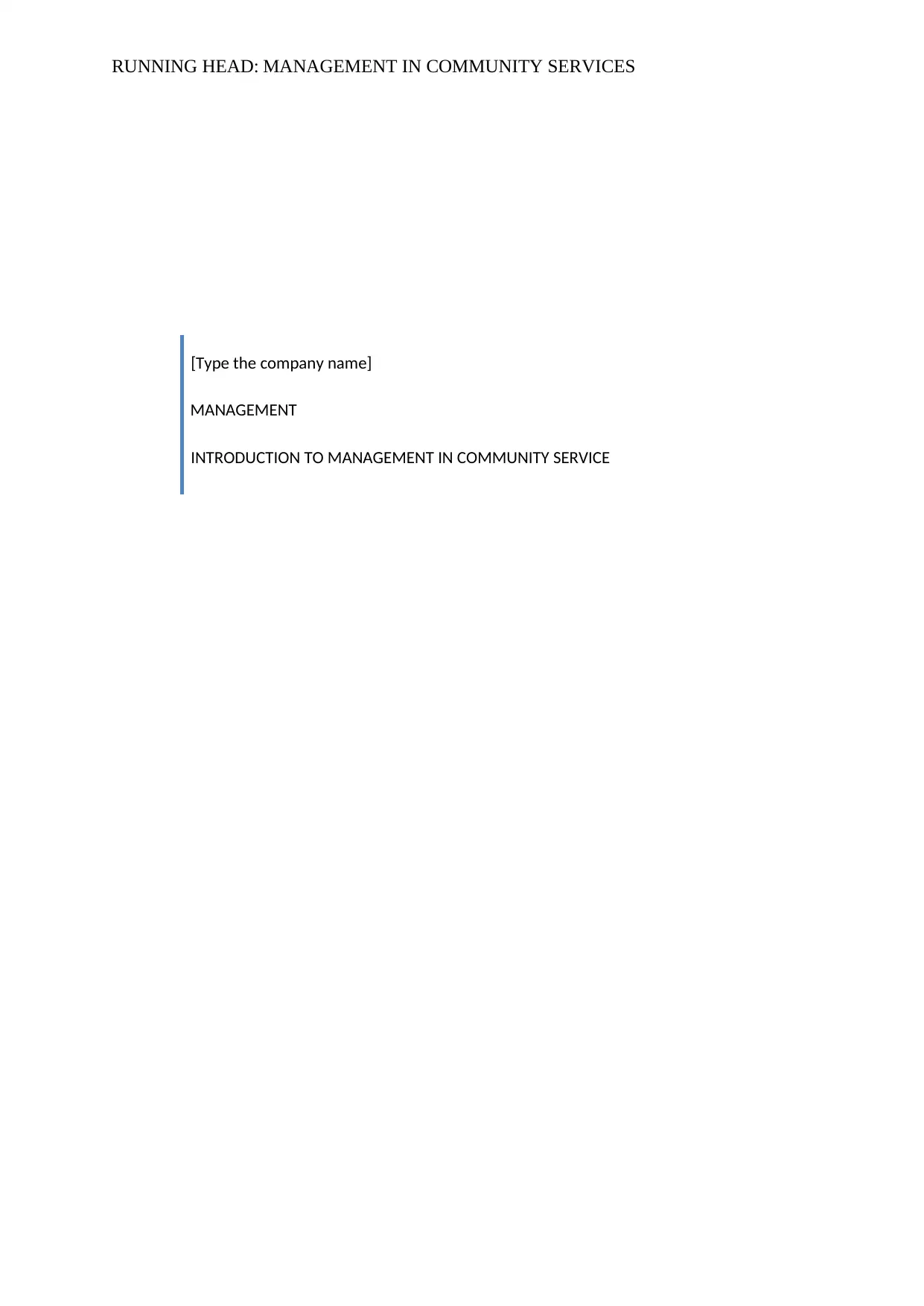
RUNNING HEAD: MANAGEMENT IN COMMUNITY SERVICES
[Type the company name]
MANAGEMENT
INTRODUCTION TO MANAGEMENT IN COMMUNITY SERVICE
[Type the company name]
MANAGEMENT
INTRODUCTION TO MANAGEMENT IN COMMUNITY SERVICE
Paraphrase This Document
Need a fresh take? Get an instant paraphrase of this document with our AI Paraphraser
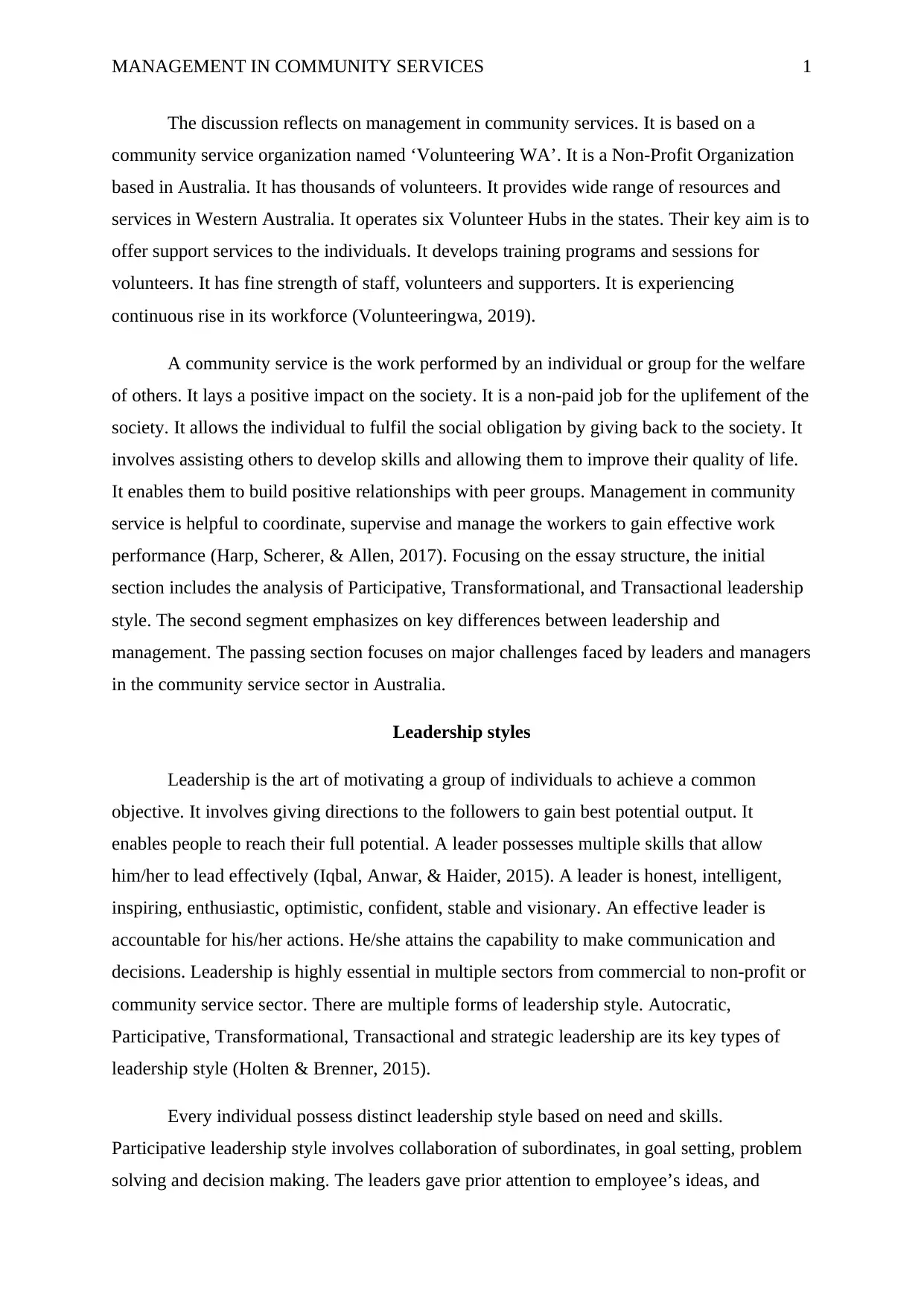
MANAGEMENT IN COMMUNITY SERVICES 1
The discussion reflects on management in community services. It is based on a
community service organization named ‘Volunteering WA’. It is a Non-Profit Organization
based in Australia. It has thousands of volunteers. It provides wide range of resources and
services in Western Australia. It operates six Volunteer Hubs in the states. Their key aim is to
offer support services to the individuals. It develops training programs and sessions for
volunteers. It has fine strength of staff, volunteers and supporters. It is experiencing
continuous rise in its workforce (Volunteeringwa, 2019).
A community service is the work performed by an individual or group for the welfare
of others. It lays a positive impact on the society. It is a non-paid job for the uplifement of the
society. It allows the individual to fulfil the social obligation by giving back to the society. It
involves assisting others to develop skills and allowing them to improve their quality of life.
It enables them to build positive relationships with peer groups. Management in community
service is helpful to coordinate, supervise and manage the workers to gain effective work
performance (Harp, Scherer, & Allen, 2017). Focusing on the essay structure, the initial
section includes the analysis of Participative, Transformational, and Transactional leadership
style. The second segment emphasizes on key differences between leadership and
management. The passing section focuses on major challenges faced by leaders and managers
in the community service sector in Australia.
Leadership styles
Leadership is the art of motivating a group of individuals to achieve a common
objective. It involves giving directions to the followers to gain best potential output. It
enables people to reach their full potential. A leader possesses multiple skills that allow
him/her to lead effectively (Iqbal, Anwar, & Haider, 2015). A leader is honest, intelligent,
inspiring, enthusiastic, optimistic, confident, stable and visionary. An effective leader is
accountable for his/her actions. He/she attains the capability to make communication and
decisions. Leadership is highly essential in multiple sectors from commercial to non-profit or
community service sector. There are multiple forms of leadership style. Autocratic,
Participative, Transformational, Transactional and strategic leadership are its key types of
leadership style (Holten & Brenner, 2015).
Every individual possess distinct leadership style based on need and skills.
Participative leadership style involves collaboration of subordinates, in goal setting, problem
solving and decision making. The leaders gave prior attention to employee’s ideas, and
The discussion reflects on management in community services. It is based on a
community service organization named ‘Volunteering WA’. It is a Non-Profit Organization
based in Australia. It has thousands of volunteers. It provides wide range of resources and
services in Western Australia. It operates six Volunteer Hubs in the states. Their key aim is to
offer support services to the individuals. It develops training programs and sessions for
volunteers. It has fine strength of staff, volunteers and supporters. It is experiencing
continuous rise in its workforce (Volunteeringwa, 2019).
A community service is the work performed by an individual or group for the welfare
of others. It lays a positive impact on the society. It is a non-paid job for the uplifement of the
society. It allows the individual to fulfil the social obligation by giving back to the society. It
involves assisting others to develop skills and allowing them to improve their quality of life.
It enables them to build positive relationships with peer groups. Management in community
service is helpful to coordinate, supervise and manage the workers to gain effective work
performance (Harp, Scherer, & Allen, 2017). Focusing on the essay structure, the initial
section includes the analysis of Participative, Transformational, and Transactional leadership
style. The second segment emphasizes on key differences between leadership and
management. The passing section focuses on major challenges faced by leaders and managers
in the community service sector in Australia.
Leadership styles
Leadership is the art of motivating a group of individuals to achieve a common
objective. It involves giving directions to the followers to gain best potential output. It
enables people to reach their full potential. A leader possesses multiple skills that allow
him/her to lead effectively (Iqbal, Anwar, & Haider, 2015). A leader is honest, intelligent,
inspiring, enthusiastic, optimistic, confident, stable and visionary. An effective leader is
accountable for his/her actions. He/she attains the capability to make communication and
decisions. Leadership is highly essential in multiple sectors from commercial to non-profit or
community service sector. There are multiple forms of leadership style. Autocratic,
Participative, Transformational, Transactional and strategic leadership are its key types of
leadership style (Holten & Brenner, 2015).
Every individual possess distinct leadership style based on need and skills.
Participative leadership style involves collaboration of subordinates, in goal setting, problem
solving and decision making. The leaders gave prior attention to employee’s ideas, and
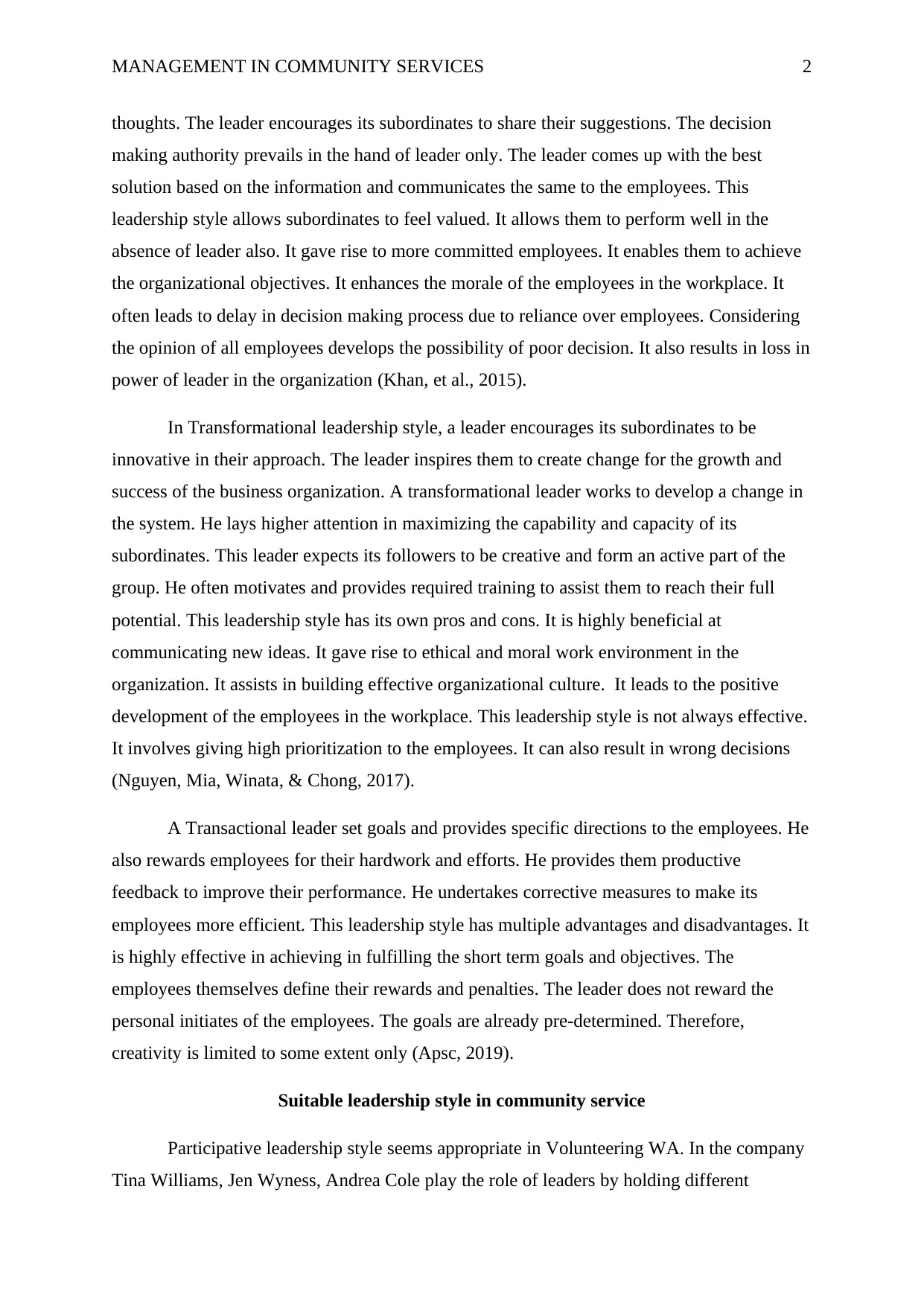
MANAGEMENT IN COMMUNITY SERVICES 2
thoughts. The leader encourages its subordinates to share their suggestions. The decision
making authority prevails in the hand of leader only. The leader comes up with the best
solution based on the information and communicates the same to the employees. This
leadership style allows subordinates to feel valued. It allows them to perform well in the
absence of leader also. It gave rise to more committed employees. It enables them to achieve
the organizational objectives. It enhances the morale of the employees in the workplace. It
often leads to delay in decision making process due to reliance over employees. Considering
the opinion of all employees develops the possibility of poor decision. It also results in loss in
power of leader in the organization (Khan, et al., 2015).
In Transformational leadership style, a leader encourages its subordinates to be
innovative in their approach. The leader inspires them to create change for the growth and
success of the business organization. A transformational leader works to develop a change in
the system. He lays higher attention in maximizing the capability and capacity of its
subordinates. This leader expects its followers to be creative and form an active part of the
group. He often motivates and provides required training to assist them to reach their full
potential. This leadership style has its own pros and cons. It is highly beneficial at
communicating new ideas. It gave rise to ethical and moral work environment in the
organization. It assists in building effective organizational culture. It leads to the positive
development of the employees in the workplace. This leadership style is not always effective.
It involves giving high prioritization to the employees. It can also result in wrong decisions
(Nguyen, Mia, Winata, & Chong, 2017).
A Transactional leader set goals and provides specific directions to the employees. He
also rewards employees for their hardwork and efforts. He provides them productive
feedback to improve their performance. He undertakes corrective measures to make its
employees more efficient. This leadership style has multiple advantages and disadvantages. It
is highly effective in achieving in fulfilling the short term goals and objectives. The
employees themselves define their rewards and penalties. The leader does not reward the
personal initiates of the employees. The goals are already pre-determined. Therefore,
creativity is limited to some extent only (Apsc, 2019).
Suitable leadership style in community service
Participative leadership style seems appropriate in Volunteering WA. In the company
Tina Williams, Jen Wyness, Andrea Cole play the role of leaders by holding different
thoughts. The leader encourages its subordinates to share their suggestions. The decision
making authority prevails in the hand of leader only. The leader comes up with the best
solution based on the information and communicates the same to the employees. This
leadership style allows subordinates to feel valued. It allows them to perform well in the
absence of leader also. It gave rise to more committed employees. It enables them to achieve
the organizational objectives. It enhances the morale of the employees in the workplace. It
often leads to delay in decision making process due to reliance over employees. Considering
the opinion of all employees develops the possibility of poor decision. It also results in loss in
power of leader in the organization (Khan, et al., 2015).
In Transformational leadership style, a leader encourages its subordinates to be
innovative in their approach. The leader inspires them to create change for the growth and
success of the business organization. A transformational leader works to develop a change in
the system. He lays higher attention in maximizing the capability and capacity of its
subordinates. This leader expects its followers to be creative and form an active part of the
group. He often motivates and provides required training to assist them to reach their full
potential. This leadership style has its own pros and cons. It is highly beneficial at
communicating new ideas. It gave rise to ethical and moral work environment in the
organization. It assists in building effective organizational culture. It leads to the positive
development of the employees in the workplace. This leadership style is not always effective.
It involves giving high prioritization to the employees. It can also result in wrong decisions
(Nguyen, Mia, Winata, & Chong, 2017).
A Transactional leader set goals and provides specific directions to the employees. He
also rewards employees for their hardwork and efforts. He provides them productive
feedback to improve their performance. He undertakes corrective measures to make its
employees more efficient. This leadership style has multiple advantages and disadvantages. It
is highly effective in achieving in fulfilling the short term goals and objectives. The
employees themselves define their rewards and penalties. The leader does not reward the
personal initiates of the employees. The goals are already pre-determined. Therefore,
creativity is limited to some extent only (Apsc, 2019).
Suitable leadership style in community service
Participative leadership style seems appropriate in Volunteering WA. In the company
Tina Williams, Jen Wyness, Andrea Cole play the role of leaders by holding different
⊘ This is a preview!⊘
Do you want full access?
Subscribe today to unlock all pages.

Trusted by 1+ million students worldwide
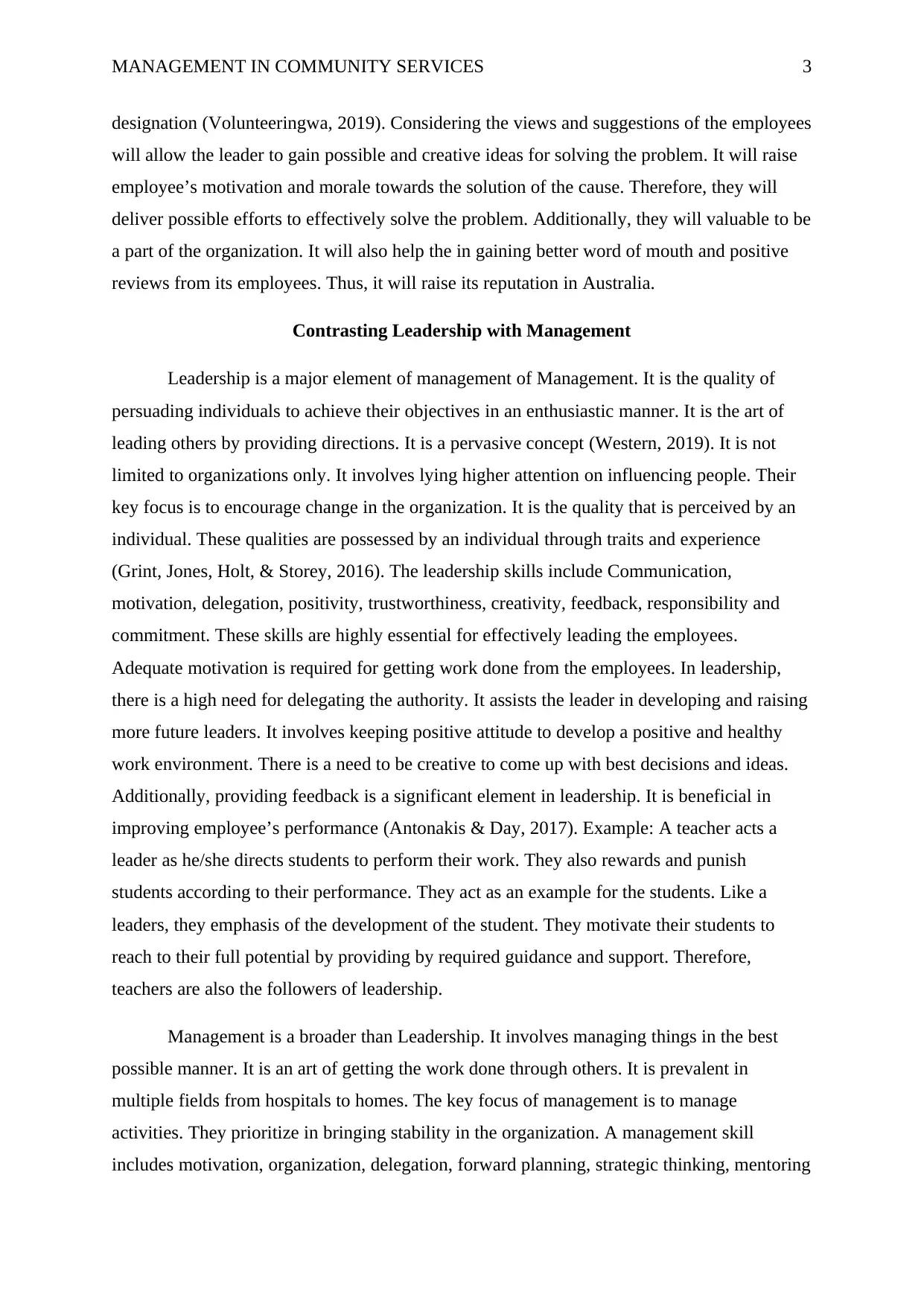
MANAGEMENT IN COMMUNITY SERVICES 3
designation (Volunteeringwa, 2019). Considering the views and suggestions of the employees
will allow the leader to gain possible and creative ideas for solving the problem. It will raise
employee’s motivation and morale towards the solution of the cause. Therefore, they will
deliver possible efforts to effectively solve the problem. Additionally, they will valuable to be
a part of the organization. It will also help the in gaining better word of mouth and positive
reviews from its employees. Thus, it will raise its reputation in Australia.
Contrasting Leadership with Management
Leadership is a major element of management of Management. It is the quality of
persuading individuals to achieve their objectives in an enthusiastic manner. It is the art of
leading others by providing directions. It is a pervasive concept (Western, 2019). It is not
limited to organizations only. It involves lying higher attention on influencing people. Their
key focus is to encourage change in the organization. It is the quality that is perceived by an
individual. These qualities are possessed by an individual through traits and experience
(Grint, Jones, Holt, & Storey, 2016). The leadership skills include Communication,
motivation, delegation, positivity, trustworthiness, creativity, feedback, responsibility and
commitment. These skills are highly essential for effectively leading the employees.
Adequate motivation is required for getting work done from the employees. In leadership,
there is a high need for delegating the authority. It assists the leader in developing and raising
more future leaders. It involves keeping positive attitude to develop a positive and healthy
work environment. There is a need to be creative to come up with best decisions and ideas.
Additionally, providing feedback is a significant element in leadership. It is beneficial in
improving employee’s performance (Antonakis & Day, 2017). Example: A teacher acts a
leader as he/she directs students to perform their work. They also rewards and punish
students according to their performance. They act as an example for the students. Like a
leaders, they emphasis of the development of the student. They motivate their students to
reach to their full potential by providing by required guidance and support. Therefore,
teachers are also the followers of leadership.
Management is a broader than Leadership. It involves managing things in the best
possible manner. It is an art of getting the work done through others. It is prevalent in
multiple fields from hospitals to homes. The key focus of management is to manage
activities. They prioritize in bringing stability in the organization. A management skill
includes motivation, organization, delegation, forward planning, strategic thinking, mentoring
designation (Volunteeringwa, 2019). Considering the views and suggestions of the employees
will allow the leader to gain possible and creative ideas for solving the problem. It will raise
employee’s motivation and morale towards the solution of the cause. Therefore, they will
deliver possible efforts to effectively solve the problem. Additionally, they will valuable to be
a part of the organization. It will also help the in gaining better word of mouth and positive
reviews from its employees. Thus, it will raise its reputation in Australia.
Contrasting Leadership with Management
Leadership is a major element of management of Management. It is the quality of
persuading individuals to achieve their objectives in an enthusiastic manner. It is the art of
leading others by providing directions. It is a pervasive concept (Western, 2019). It is not
limited to organizations only. It involves lying higher attention on influencing people. Their
key focus is to encourage change in the organization. It is the quality that is perceived by an
individual. These qualities are possessed by an individual through traits and experience
(Grint, Jones, Holt, & Storey, 2016). The leadership skills include Communication,
motivation, delegation, positivity, trustworthiness, creativity, feedback, responsibility and
commitment. These skills are highly essential for effectively leading the employees.
Adequate motivation is required for getting work done from the employees. In leadership,
there is a high need for delegating the authority. It assists the leader in developing and raising
more future leaders. It involves keeping positive attitude to develop a positive and healthy
work environment. There is a need to be creative to come up with best decisions and ideas.
Additionally, providing feedback is a significant element in leadership. It is beneficial in
improving employee’s performance (Antonakis & Day, 2017). Example: A teacher acts a
leader as he/she directs students to perform their work. They also rewards and punish
students according to their performance. They act as an example for the students. Like a
leaders, they emphasis of the development of the student. They motivate their students to
reach to their full potential by providing by required guidance and support. Therefore,
teachers are also the followers of leadership.
Management is a broader than Leadership. It involves managing things in the best
possible manner. It is an art of getting the work done through others. It is prevalent in
multiple fields from hospitals to homes. The key focus of management is to manage
activities. They prioritize in bringing stability in the organization. A management skill
includes motivation, organization, delegation, forward planning, strategic thinking, mentoring
Paraphrase This Document
Need a fresh take? Get an instant paraphrase of this document with our AI Paraphraser
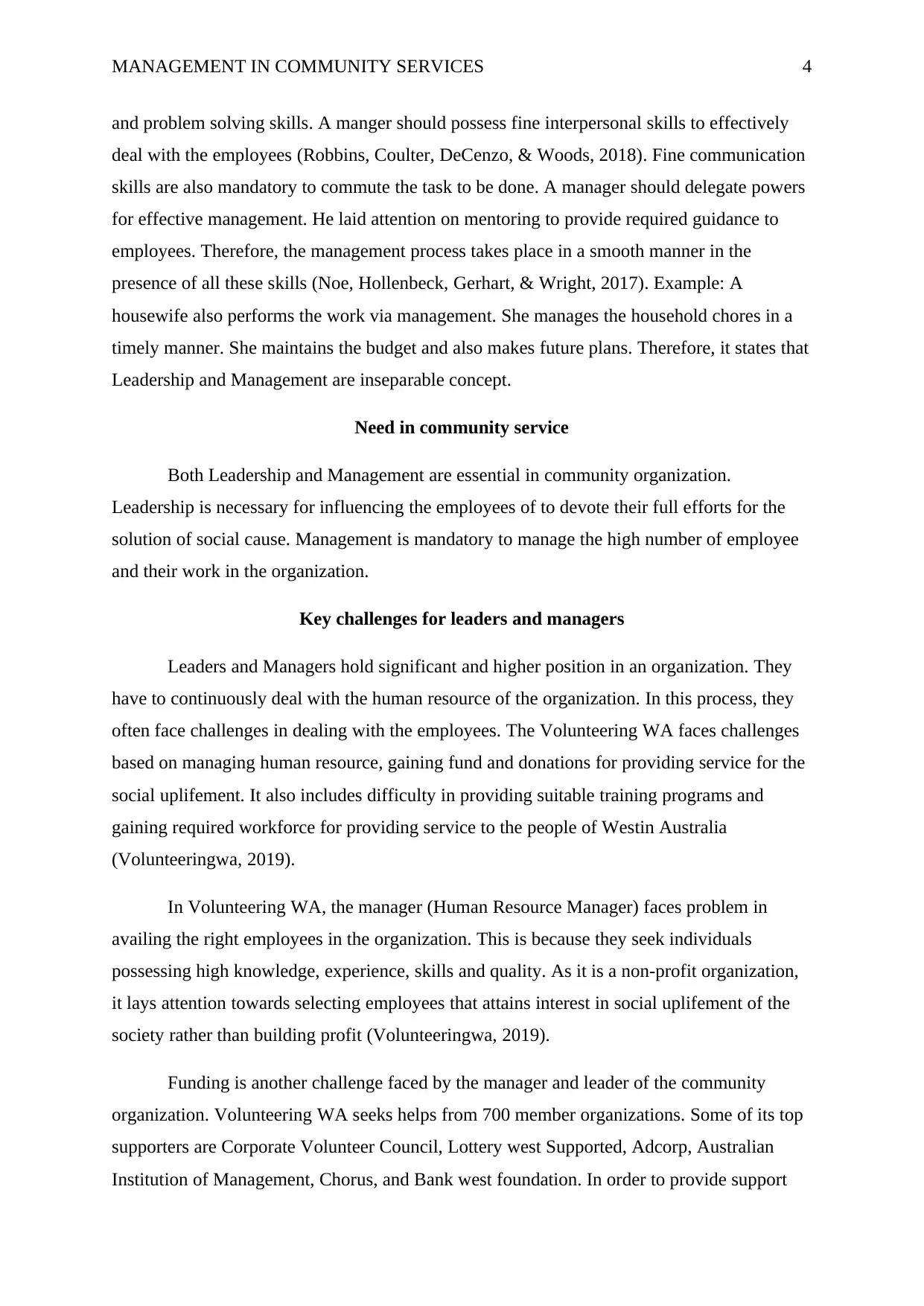
MANAGEMENT IN COMMUNITY SERVICES 4
and problem solving skills. A manger should possess fine interpersonal skills to effectively
deal with the employees (Robbins, Coulter, DeCenzo, & Woods, 2018). Fine communication
skills are also mandatory to commute the task to be done. A manager should delegate powers
for effective management. He laid attention on mentoring to provide required guidance to
employees. Therefore, the management process takes place in a smooth manner in the
presence of all these skills (Noe, Hollenbeck, Gerhart, & Wright, 2017). Example: A
housewife also performs the work via management. She manages the household chores in a
timely manner. She maintains the budget and also makes future plans. Therefore, it states that
Leadership and Management are inseparable concept.
Need in community service
Both Leadership and Management are essential in community organization.
Leadership is necessary for influencing the employees of to devote their full efforts for the
solution of social cause. Management is mandatory to manage the high number of employee
and their work in the organization.
Key challenges for leaders and managers
Leaders and Managers hold significant and higher position in an organization. They
have to continuously deal with the human resource of the organization. In this process, they
often face challenges in dealing with the employees. The Volunteering WA faces challenges
based on managing human resource, gaining fund and donations for providing service for the
social uplifement. It also includes difficulty in providing suitable training programs and
gaining required workforce for providing service to the people of Westin Australia
(Volunteeringwa, 2019).
In Volunteering WA, the manager (Human Resource Manager) faces problem in
availing the right employees in the organization. This is because they seek individuals
possessing high knowledge, experience, skills and quality. As it is a non-profit organization,
it lays attention towards selecting employees that attains interest in social uplifement of the
society rather than building profit (Volunteeringwa, 2019).
Funding is another challenge faced by the manager and leader of the community
organization. Volunteering WA seeks helps from 700 member organizations. Some of its top
supporters are Corporate Volunteer Council, Lottery west Supported, Adcorp, Australian
Institution of Management, Chorus, and Bank west foundation. In order to provide support
and problem solving skills. A manger should possess fine interpersonal skills to effectively
deal with the employees (Robbins, Coulter, DeCenzo, & Woods, 2018). Fine communication
skills are also mandatory to commute the task to be done. A manager should delegate powers
for effective management. He laid attention on mentoring to provide required guidance to
employees. Therefore, the management process takes place in a smooth manner in the
presence of all these skills (Noe, Hollenbeck, Gerhart, & Wright, 2017). Example: A
housewife also performs the work via management. She manages the household chores in a
timely manner. She maintains the budget and also makes future plans. Therefore, it states that
Leadership and Management are inseparable concept.
Need in community service
Both Leadership and Management are essential in community organization.
Leadership is necessary for influencing the employees of to devote their full efforts for the
solution of social cause. Management is mandatory to manage the high number of employee
and their work in the organization.
Key challenges for leaders and managers
Leaders and Managers hold significant and higher position in an organization. They
have to continuously deal with the human resource of the organization. In this process, they
often face challenges in dealing with the employees. The Volunteering WA faces challenges
based on managing human resource, gaining fund and donations for providing service for the
social uplifement. It also includes difficulty in providing suitable training programs and
gaining required workforce for providing service to the people of Westin Australia
(Volunteeringwa, 2019).
In Volunteering WA, the manager (Human Resource Manager) faces problem in
availing the right employees in the organization. This is because they seek individuals
possessing high knowledge, experience, skills and quality. As it is a non-profit organization,
it lays attention towards selecting employees that attains interest in social uplifement of the
society rather than building profit (Volunteeringwa, 2019).
Funding is another challenge faced by the manager and leader of the community
organization. Volunteering WA seeks helps from 700 member organizations. Some of its top
supporters are Corporate Volunteer Council, Lottery west Supported, Adcorp, Australian
Institution of Management, Chorus, and Bank west foundation. In order to provide support

MANAGEMENT IN COMMUNITY SERVICES 5
service to the people of Westin Australia is experiences difficulty in raising donations and
sponsorships (Volunteeringwa, 2019).
Volunteering WA has high number of volunteers. In the organization leaders often
faces problem in managing the human resource of the organization. This is because they
attain diverse workforce. They acknowledge difficulty in considering the ideas and
suggestions of all the volunteers. They have to devote high time and efforts in maintaining
the employee morale. As it is a Non-Profit organization, leaders and managers does not rely
on financial resources to motivate the volunteers. Thus, in the absence of financial incentives,
it experiences problems in motivating its volunteers to perform to their highest potential.
Additionally, the manager faces difficulty in maintaining the dedication level of its
employees (Volunteeringwa, 2019). Therefore, it can be stated that Human Resource
Management is one of the basic and highly essential challenge of Volunteering WA.
It develops training programs for its volunteers. It faces problem in setting up training
programs suitable for each human resource. This is because it has diverse workforce.
Therefore, it acts a challenge for the manager and leaders to develop the use of appropriate
method of training that will be easily understood and conceived by the volunteers as well as
higher authority of Volunteering WA (Volunteeringwa, 2019). The leader has to devote high
time in carefully examining the suitable training programs for its volunteers.
The essay summarizes the concept of management in Community organization. From
the above discussion, it is analyzed that community service involves working for non-profit
motive. It is acknowledged that there are many forms of leadership styles. It mainly includes
Participative, Transformational and Transactional leadership style. Participative leadership
style involves gaining the collaboration of employees in work process. Transformational
Leader focuses on being innovative in their approach whereas Transactional leadership
involves giving feedback to the employees for improving their performance. In the
community organization, participative leadership style is suitable as it will assist in
developing motivation and seeking creative and new ideas from the employees of
Volunteering WA. It is assessed that Leadership and Management are two different yet
interrelated concepts. Leadership involves giving directions and motivating employees to
reach their full potential. Management deals with managing the human resource of the
organization to get the work done. It is acknowledged that leadership is a part of
management. It is analyzed that both leadership and management are significant concept for
service to the people of Westin Australia is experiences difficulty in raising donations and
sponsorships (Volunteeringwa, 2019).
Volunteering WA has high number of volunteers. In the organization leaders often
faces problem in managing the human resource of the organization. This is because they
attain diverse workforce. They acknowledge difficulty in considering the ideas and
suggestions of all the volunteers. They have to devote high time and efforts in maintaining
the employee morale. As it is a Non-Profit organization, leaders and managers does not rely
on financial resources to motivate the volunteers. Thus, in the absence of financial incentives,
it experiences problems in motivating its volunteers to perform to their highest potential.
Additionally, the manager faces difficulty in maintaining the dedication level of its
employees (Volunteeringwa, 2019). Therefore, it can be stated that Human Resource
Management is one of the basic and highly essential challenge of Volunteering WA.
It develops training programs for its volunteers. It faces problem in setting up training
programs suitable for each human resource. This is because it has diverse workforce.
Therefore, it acts a challenge for the manager and leaders to develop the use of appropriate
method of training that will be easily understood and conceived by the volunteers as well as
higher authority of Volunteering WA (Volunteeringwa, 2019). The leader has to devote high
time in carefully examining the suitable training programs for its volunteers.
The essay summarizes the concept of management in Community organization. From
the above discussion, it is analyzed that community service involves working for non-profit
motive. It is acknowledged that there are many forms of leadership styles. It mainly includes
Participative, Transformational and Transactional leadership style. Participative leadership
style involves gaining the collaboration of employees in work process. Transformational
Leader focuses on being innovative in their approach whereas Transactional leadership
involves giving feedback to the employees for improving their performance. In the
community organization, participative leadership style is suitable as it will assist in
developing motivation and seeking creative and new ideas from the employees of
Volunteering WA. It is assessed that Leadership and Management are two different yet
interrelated concepts. Leadership involves giving directions and motivating employees to
reach their full potential. Management deals with managing the human resource of the
organization to get the work done. It is acknowledged that leadership is a part of
management. It is analyzed that both leadership and management are significant concept for
⊘ This is a preview!⊘
Do you want full access?
Subscribe today to unlock all pages.

Trusted by 1+ million students worldwide

MANAGEMENT IN COMMUNITY SERVICES 6
directing and managing the human resource of Volunteering WA. Additionally, it is
evaluated that leaders and managers faces multiple challenges in the community service
sector in Australia. It includes funding managing human resource, developing suitable
training programs, motivating employees and maintaining their dedication in the work.
Hence, it concludes that leadership and management is an essential concept in community
service sector as well. Therefore, manger and leaders have to lay high focus in fulfilling the
challenges for an effective functioning of the Volunteering Westin Australia.
directing and managing the human resource of Volunteering WA. Additionally, it is
evaluated that leaders and managers faces multiple challenges in the community service
sector in Australia. It includes funding managing human resource, developing suitable
training programs, motivating employees and maintaining their dedication in the work.
Hence, it concludes that leadership and management is an essential concept in community
service sector as well. Therefore, manger and leaders have to lay high focus in fulfilling the
challenges for an effective functioning of the Volunteering Westin Australia.
Paraphrase This Document
Need a fresh take? Get an instant paraphrase of this document with our AI Paraphraser
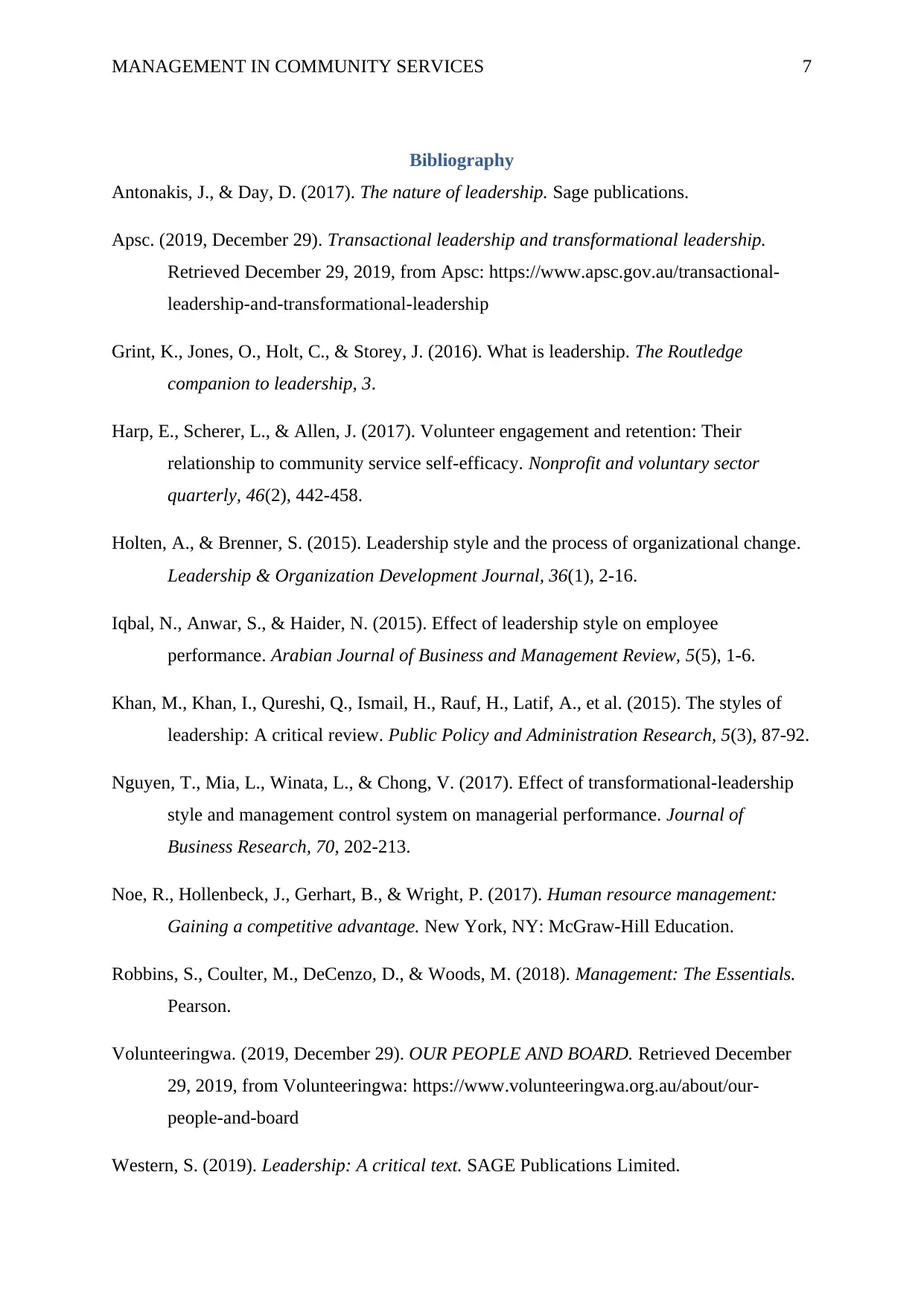
MANAGEMENT IN COMMUNITY SERVICES 7
Bibliography
Antonakis, J., & Day, D. (2017). The nature of leadership. Sage publications.
Apsc. (2019, December 29). Transactional leadership and transformational leadership.
Retrieved December 29, 2019, from Apsc: https://www.apsc.gov.au/transactional-
leadership-and-transformational-leadership
Grint, K., Jones, O., Holt, C., & Storey, J. (2016). What is leadership. The Routledge
companion to leadership, 3.
Harp, E., Scherer, L., & Allen, J. (2017). Volunteer engagement and retention: Their
relationship to community service self-efficacy. Nonprofit and voluntary sector
quarterly, 46(2), 442-458.
Holten, A., & Brenner, S. (2015). Leadership style and the process of organizational change.
Leadership & Organization Development Journal, 36(1), 2-16.
Iqbal, N., Anwar, S., & Haider, N. (2015). Effect of leadership style on employee
performance. Arabian Journal of Business and Management Review, 5(5), 1-6.
Khan, M., Khan, I., Qureshi, Q., Ismail, H., Rauf, H., Latif, A., et al. (2015). The styles of
leadership: A critical review. Public Policy and Administration Research, 5(3), 87-92.
Nguyen, T., Mia, L., Winata, L., & Chong, V. (2017). Effect of transformational-leadership
style and management control system on managerial performance. Journal of
Business Research, 70, 202-213.
Noe, R., Hollenbeck, J., Gerhart, B., & Wright, P. (2017). Human resource management:
Gaining a competitive advantage. New York, NY: McGraw-Hill Education.
Robbins, S., Coulter, M., DeCenzo, D., & Woods, M. (2018). Management: The Essentials.
Pearson.
Volunteeringwa. (2019, December 29). OUR PEOPLE AND BOARD. Retrieved December
29, 2019, from Volunteeringwa: https://www.volunteeringwa.org.au/about/our-
people-and-board
Western, S. (2019). Leadership: A critical text. SAGE Publications Limited.
Bibliography
Antonakis, J., & Day, D. (2017). The nature of leadership. Sage publications.
Apsc. (2019, December 29). Transactional leadership and transformational leadership.
Retrieved December 29, 2019, from Apsc: https://www.apsc.gov.au/transactional-
leadership-and-transformational-leadership
Grint, K., Jones, O., Holt, C., & Storey, J. (2016). What is leadership. The Routledge
companion to leadership, 3.
Harp, E., Scherer, L., & Allen, J. (2017). Volunteer engagement and retention: Their
relationship to community service self-efficacy. Nonprofit and voluntary sector
quarterly, 46(2), 442-458.
Holten, A., & Brenner, S. (2015). Leadership style and the process of organizational change.
Leadership & Organization Development Journal, 36(1), 2-16.
Iqbal, N., Anwar, S., & Haider, N. (2015). Effect of leadership style on employee
performance. Arabian Journal of Business and Management Review, 5(5), 1-6.
Khan, M., Khan, I., Qureshi, Q., Ismail, H., Rauf, H., Latif, A., et al. (2015). The styles of
leadership: A critical review. Public Policy and Administration Research, 5(3), 87-92.
Nguyen, T., Mia, L., Winata, L., & Chong, V. (2017). Effect of transformational-leadership
style and management control system on managerial performance. Journal of
Business Research, 70, 202-213.
Noe, R., Hollenbeck, J., Gerhart, B., & Wright, P. (2017). Human resource management:
Gaining a competitive advantage. New York, NY: McGraw-Hill Education.
Robbins, S., Coulter, M., DeCenzo, D., & Woods, M. (2018). Management: The Essentials.
Pearson.
Volunteeringwa. (2019, December 29). OUR PEOPLE AND BOARD. Retrieved December
29, 2019, from Volunteeringwa: https://www.volunteeringwa.org.au/about/our-
people-and-board
Western, S. (2019). Leadership: A critical text. SAGE Publications Limited.

MANAGEMENT IN COMMUNITY SERVICES 8
⊘ This is a preview!⊘
Do you want full access?
Subscribe today to unlock all pages.

Trusted by 1+ million students worldwide
1 out of 9
Related Documents
Your All-in-One AI-Powered Toolkit for Academic Success.
+13062052269
info@desklib.com
Available 24*7 on WhatsApp / Email
![[object Object]](/_next/static/media/star-bottom.7253800d.svg)
Unlock your academic potential
Copyright © 2020–2025 A2Z Services. All Rights Reserved. Developed and managed by ZUCOL.





